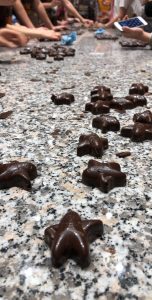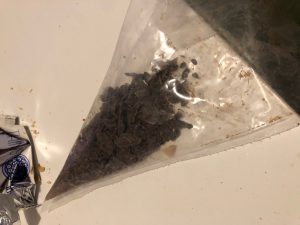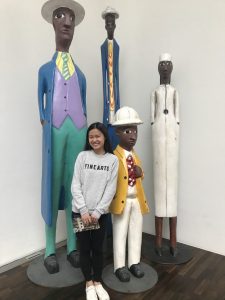On Monday, the NBB Paris crew took a trip to the Musée du Chocolat. After an hour of mastering the history of cocoa bean trade and origins of chocolate production, we had the opportunity to learn the chocolatiering craft. We were brought to the kitchen of Monsieur Chocolatier (name unknown), where he taught us how to make chocolate molds, fill them, and seal them. He said that we were less skilled and louder than the groups of children he taught (perhaps with the exception of Ashley and I, who will be releasing our new chocolate line shortly). He also said that he liked that we were loud because it meant we were happy. Apparently, his French visitors are very serious about their chocolate education and rarely smile in his class. From the pictures taken during our lesson and at the museum, Monsieur Chocolatier seems to have spoken the truth. Even beyond the chocolate museum, the NBB group seems to be radiating positive emotions in response to French novelties (and French food). The following is a sneak peak of my photo collection “PA Paris” and a neuroscience review of positive emotion experience. For reference, PA stands for Positive Affect state, a state in which humans report to feel fundamentally happy. The most effective method to measure this state is debated among neuroscientists, but self-report ratings and observation of unconditioned behavior such as Duchenne smiling are frequently used (Burgdof and Panksepp, 2006).
Chocolate Workshop
We visited a chocolate museum/workshop on Monday. The museum displays the history of cocoa consumption, the techniques of making chocolate and things that are made of chocolate but seem like they are made of other materials. There is free chocolate everywhere in the museum. As I mentioned in my previous post, I have a disproportionally large stomach, and therefore I always appreciated places where I can eat as much food as I want. I paced myself, however, because I knew there would be more coming once we were in the workshop.
Cocoa beans, which are the raw material for chocolate, are not cultivated in France: they are mainly produced in tropical African, Asian and American countries. So French is not that unique in respect to chocolate: everyone’s chocolate is made of beans from countries such as Cote d’Ivoire, Ghana, Indonesia and Nigeria (Mattyasovszky, 2017). The French, however, create pieces of chocolate so pretty that they are worth building a museum for. I remember that my dad once brought me a box of chocolate from France years ago, and I could not eat it because it was so pretty. So I just kept them until they had gone bad. I would not expect to see a similar place in the US because people do not care too much about how their chocolate looks.
We went to the workshop after the museum. The chocolate expert made the process look easy, but it was not. We had to dump the warmed up liquid chocolate into the mold quickly before it cooled down and hardened. We had to hit the mold on the side with the spatula, and the melted chocolate just fell everywhere: on the table, on our hands, and on our cloth. I ate all the chocolate that landed on my hands. Then we added hazelnut filling and another layer of chocolate before putting it in the fridge to cool. The end result was not ideal, as half of my chocolate pieces were broken. But I took a lot of chocolate scratched from the table, so I was happy.

Do you know that one study has shown that eating cocoa flavanol (a component of chocolate) regularly might improve cognitive function in elderly people who have mild cognitive impairment (Desideri et al., 2012)? More studies found evidence of the potential cognitive benefit of chronic intake of cocoa flavanol (Socci et al., 2017). So I hope my brain will become healthier as I eat all the chocolate scratched from the table.

Reference
Desideri, Giovambattista, Kwik-Uribe, Catherine, Grassi, Davide, Necozione, Stefano, Ghiadoni, Lorenzo, Mastroiacovo, Daniela, . . . Ferri, Claudio. (2012). Benefits in cognitive function, blood pressure, and insulin resistance through cocoa flavanol consumption in elderly subjects with mild cognitive impairment: The Cocoa, Cognition, and Aging (CoCoA) study. Hypertension., 60(3), 794-801.
Mattyasovszky, M. (2015, April 23). Top 10 Cocoa Producing Countries. Retrieved from https://www.worldatlas.com/articles/top-10-cocoa-producing-countries.html
Socci, V., Tempesta, D., Desideri, G., De Gennaro, L., & Ferrara, M. (2017). Enhancing Human Cognition with Cocoa Flavonoids. Frontiers in Nutrition., 4, 19.
Intersection between East and West
When Nazi occupied Paris in 1940, Hitler posed in front of his favorite place in Paris, the Eiffel tower. Why he posed in front of Eiffel tower instead of posing on the top of the Eiffel tower? The lift of the tower was sabotaged before Nazi conquered Paris. Therefore, there was a saying that Hitler conquered Paris, but he never conquers Eiffel tower (Selwyn-Holmes, 2010). Speaking of that famous picture, the picture was taken in the front terrace of the Musée de l’Homme, an anthropology museum that contains collections of human in evolution, diversity of human and human in social contexts. On one of our class trips, we visited Musée de l’Homme. Among all of the historical human skeletons and artifacts, I saw a familiar Chinese acupuncture man model with lots of acupuncture points labeled on the body. After being practiced in China and other countries for thousands of years, acupuncture became one of the alternative medicine in western world. How does acupuncture become a common practice and how does it work?

Me with the super tall guys
A Tasty Treat!
This past week, the NBB class visited the Musee du Chocolat! I have to say, I had been anticipating this specific visit since the day I read the syllabus. From my excitement, you can guess that I enjoy anything chocolate and appreciated acquiring so much knowledge about a sweet treat I had indulged in frequently, yet knew nothing about.
In fact, our class was in the midst of completing an NBB 402W assignment to read and analyze an article all about cocoa flavanols and their effects on temporal and spatial attention. I grew interested to learn more about the topic to justify all the chocolate I had eaten while doing my Emory homework these past two years. Most importantly, I wanted to learn more about French culture. The article discussed that cocoa flavanols actually increase visual attention and reaction times. However, it also did conclude that cocoa flavanols do not have a significant effect on temporal attention. (Karabay et. al, 2017). As I read the article, I began to realize that I knew nothing about the science of chocolate and that being able to learn and then discuss that information after visiting the museum would be both a culminating experience and a sweet treat in itself!
Chocolate and Memory
On Monday, we went to a chocolate museum, which went well with the paper we were writing at the time about the effects of cocoa flavanols on attention. At this museum, we started out learning about the history of chocolate and got to taste samples periodically throughout the museum. Milk chocolate is usually my favorite, but the white chocolate samples were equally good here. At the end, we even got to learn how to make our own! The process was extremely messy but a lot of fun at the same time. We had to make chocolate shells, add in some filling, and cover the end with more chocolate. My first tray was ruined because we waited too long to pour the chocolate, so it was extremely hard to pour. Luckily, we were allowed to try again with another tray.

Figure 1. Me and my roommates with the chocolate we made!
Craving something new!
I have always been a fan of chocolate. Ever since I was a little kid, any box, bag, or bar of chocolate barely lasted a day in our house before my brother, and I devoured it. Who could blame us? The rich and sweet taste of chocolate was irresistible, and it never got boring. Throughout the years I had never questioned my love for chocolate. I found my love supported by the hundreds of commercials that aired on TV displaying different types of this sweet treat. This week, for my Neuroscience class we analyzed a paper on cocoa flavanols—an ingredient in chocolate. I was surprised! Could our societal love for chocolate have a biological basis?
To supplement our cocoa flavanol exploration, we also visited a chocolate museum to understand chocolate’s history. It was very interesting to see the different ways chocolate was prepared in different areas and times throughout history. In ancient South American Civilizations, cocoa beans were used as currency and were even often offered to deities. It was clear to see that cocoa beans held tremendous value to the people of these civilizations. Later, we even had the opportunity to make chocolate ourselves. It was amazing to see the chocolate making process and how it has evolved over human history. Continue reading “Craving something new!”
The Evolution of Language
Throughout my life, I’ve never had any real problems when it comes to language barriers. In the several weeks I’ve been in Paris, however, I’ve experienced some difficulties because I don’t speak French. As much as I try, I can’t even get myself to pronounce a word in French correctly. This made me wonder why humans have such complex languages, and how this unique human feature evolved. Language is, after all, the greatest social tool we possess (Ardilla, 2015). Yesterday, we visited the Musée de l’homme, an anthropology museum in Paris, and I got an insight onto how this human ability might have developed.
The first part of the museum we visited was the Neanderthal exhibit. Here, we learned that Neanderthals are an extinct species in the genus Homo, who lived in Euroasia roughly 430,000 years ago. What sparked my attention, however, was a section in which morphological characteristics such as the lowered larynx and the hyoid bone of the Neanderthal were identified, and these confirmed that Neanderthals could articulate a great number of sounds: among them vowels. Not only that, but the FoxP2 gene, similar to the one associated with language in modern humans, was present in their DNA. Neanderthals also had intricate social structures and symbolic thought, two things that may be evidence of a complex form of communication. In the brain, their Broca’s and Wernicke’s area for language were well developed. Ardilla 2015 says “It is proposed that grammar originated from the internal representation of actions, resulting in the creation of verbs; this is an ability that depends on the so-called Broca’s area.” This made me wonder how far behind in our history language goes.
Chocolate and Happiness
Last Tuesday we were finishing up our last few classes reading about and discussing the cognitive enhancement effects seen in chocolate. Because France is known for their rich chocolate, to celebrate our new knowledge of the field we went off to visit a chocolate museum. However, there was more than met the eye at this particular museum. On the basement floor, there was an area where the owners made chocolate themselves, which you could buy in the gift store, but, even more exciting, you could also make the chocolate yourselves!

At the museum I wandered around looking at the the history of chocolate, but as I looked at and read about the historical and ritual practices of chocolate, in the back of my mind I was thinking about getting to make the chocolate myself (and of course eat it)! Continue reading “Chocolate and Happiness”
Chocolate: Good for the Brain, Good for the Soul
This week we went to the Le Musée Gourmand Du Chocolat, where we not only toured the museum, but we also participated in a workshop where we learned (hands-on!) part of how chocolate is made. The museum was very thorough, beginning with how cocoa beans were used by indigenous Americans for making drinks and even trading as currency. What we learned about the purported health benefits of chocolate from the museum tied into what we learned in class about cocoa flavanols’ potential ability to sharpen our brains’ function. An article we discussed this week at length and wrote a review article on provided evidence that cocoa flavanols “enhance the efficiency of spatial attention” (Karabay, Saija, Field, & Akyürek 2018). Therefore, chocolate may not only be good for our taste buds, but also our brains!
The chocolate workshop was really interesting because the chef at the museum that ran our workshop taught us a lot about how different beans are selected for different flavors, how beans are prepared to make different kinds of chocolate, and how different fillings are added to create various chocolatey delights.

Continue reading “Chocolate: Good for the Brain, Good for the Soul”
Musee de l’Homme Neantherthal Exhibit
On an excursion to Musee de l’Homme Neantherthal, our class ventured into human history. When I say human, I’m referring to the hominid family, which encompasses several species within the homo genus from which our modern human lineage formed. Long ago, in early human evolution, we co-inhabited this planet with other species of hominids, including Neanderthals. Neanderthals only recently went extinct at around 35,000 years ago. Leaving behind skeletons, skull bones, and Lithic tools, Neanderthals have left scientists with enough information to piece together their 350,000 plus history on earth as well as insights to the known Neanderthal-Sapien encounters that occurred in our migration out of Africa (“Néandertal L’Expo,” 2018).
The exhibit displayed old hunting and cooking tools of these ancient humans, dwellings that have been attributed to Neanderthal tribes, simulations of their sounds and language, analysis of the Neanderthal brains based on fossil records, replications of the Neanderthal male and female, and hypothesises around the encounters that occurred between our own species and this extinct species. Interestingly enough, Neanderthal DNA was found in modern humans. When we encounter this species, genetic testing suggests that interbreeding definitely occurred. Genomic studies discovered that keratin filament genes in non-African humans display a high frequency of Neanderthal alleles. These findings suggest Neanderthal alleles may have improved our ability to adapt to the non-African regions. While some Neanderthal DNA may contribute to our global existence today, the study also found some Neanderthal alleles found in our DNA today can confer risk of disease. These disease include lupus, biliary cirrhosis, Crohn’s disease, optic-disk size, smoking behaviour, IL-18 levels and type 2 diabetes (Sankaraman et. al., 2014).
